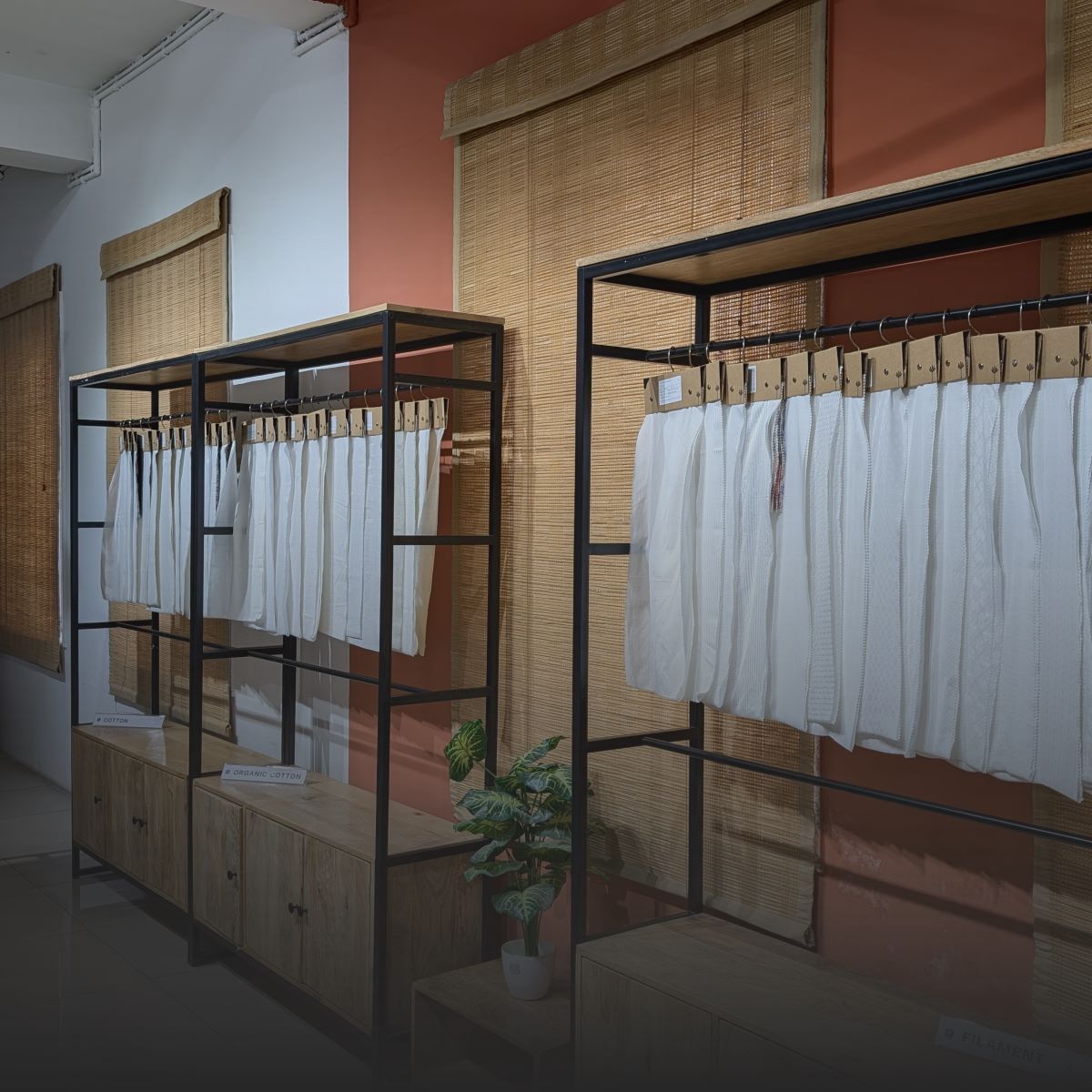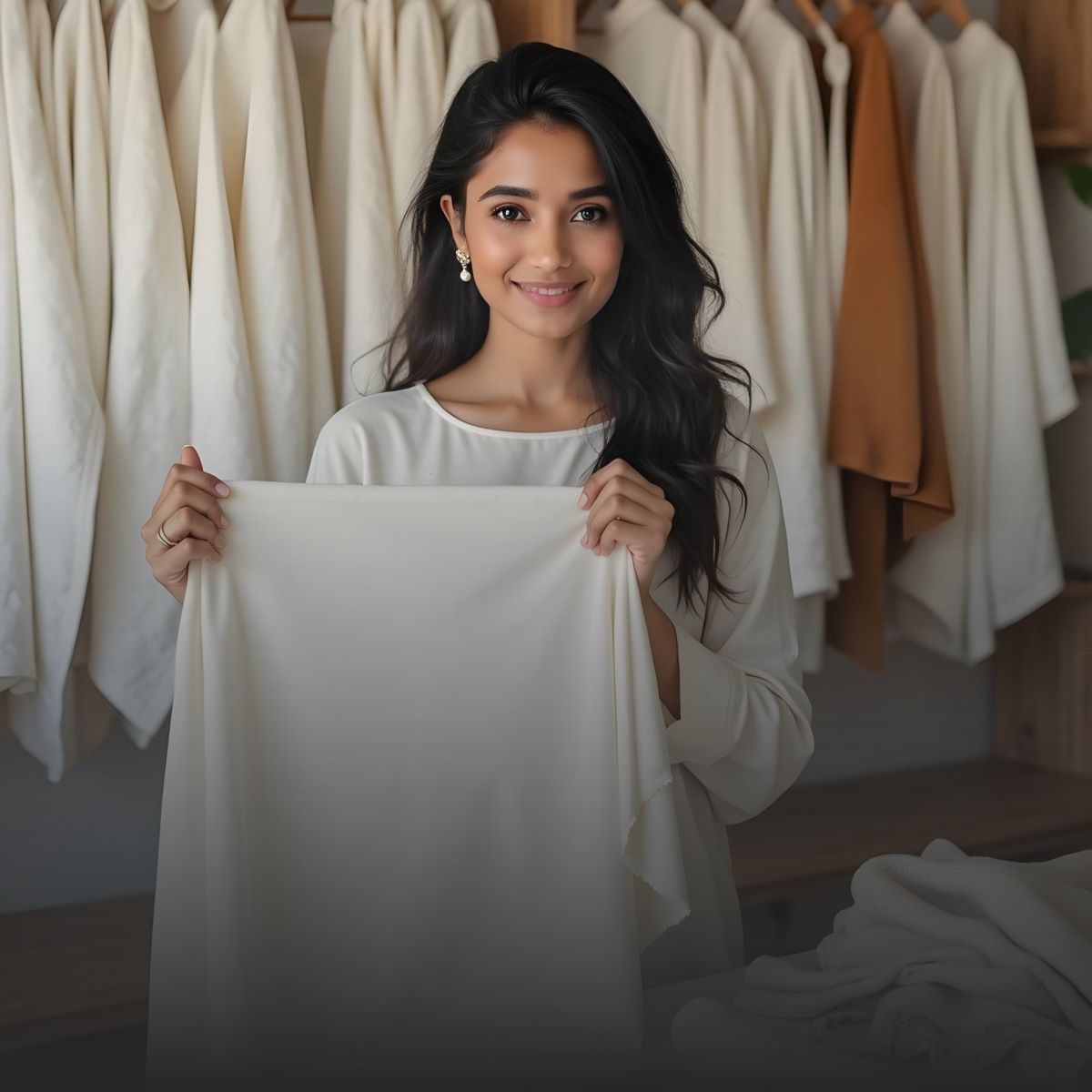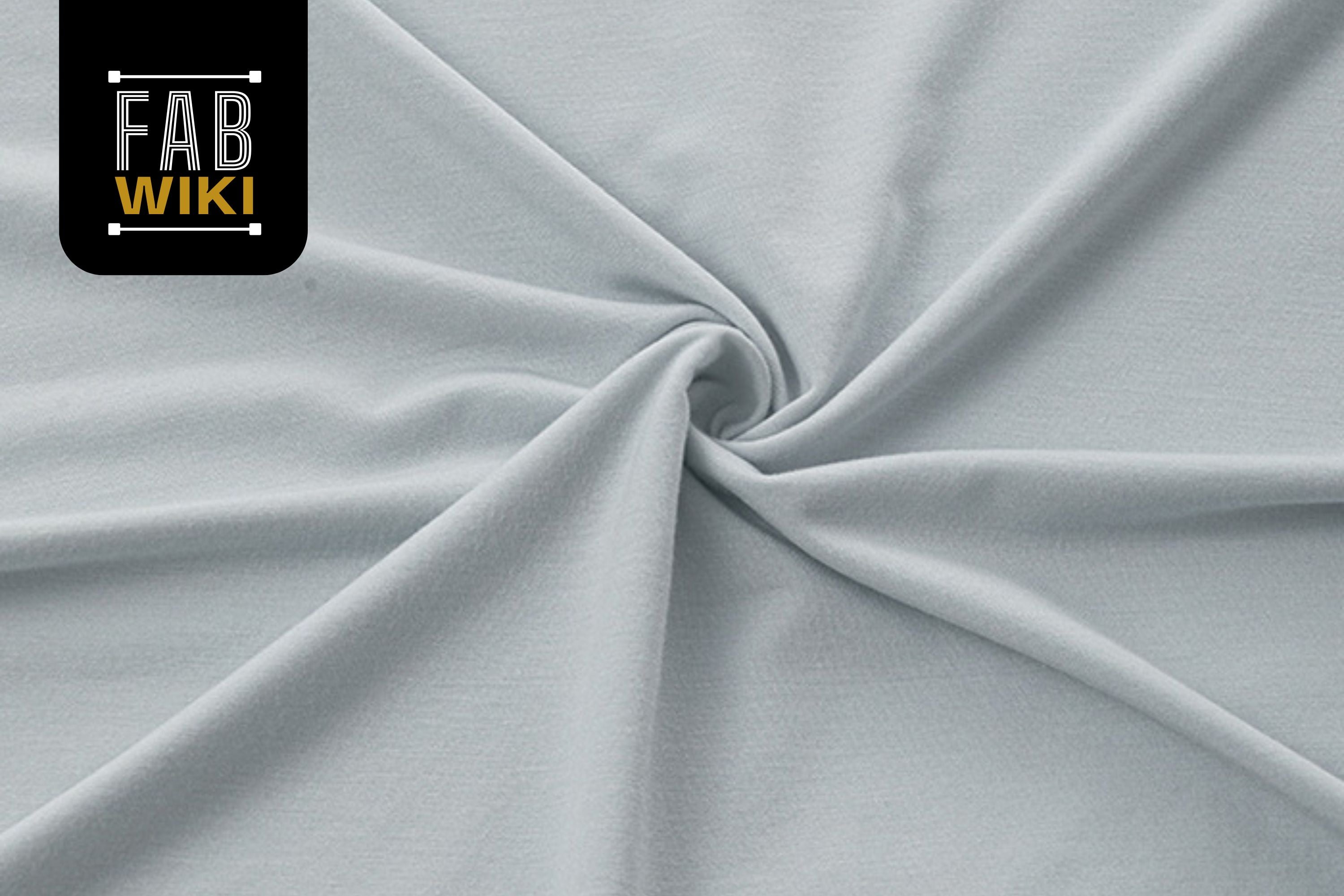Art Silk Fabric—short for artificial silk—has become one of the most versatile and cost-effective fabrics in modern fashion. It replicates the luxurious sheen, softness, and drape of natural silk while offering better durability, affordability, and easier maintenance.
Whether you're a designer, apparel manufacturer, or textile buyer, this guide explains everything about art silk—its composition, benefits, sourcing process, and applications—plus how platforms like Fabriclore can help you develop it on demand with full customization.
What Is Art Silk Fabric?
Art silk is an artificial textile engineered to mimic the lustre and feel of real silk. It's created from cellulosic fibers like viscose/rayon or synthetic polymers such as polyester and nylon.
The goal is simple: achieve the luxury of silk without its cost or ethical concerns. Art silk can be made into a wide range of fabrics, from light chiffons to stiff taffetas. This makes it a favorite among designers for both traditional and modern clothing.
Key Characteristics of Art Silk Fabric
Art silk is both aesthetically pleasing and functional, giving creators a lot of options for a wide range of products. It looks expensive because of its natural shine and smooth feel, but it's also useful for everyday wear and easy to clean.
- Smooth, lustrous surface that resembles natural silk.
- Lightweight and breathable, ideal for tropical climates.
- Excellent dye and print absorption.
- Moderate wrinkle resistance; improved with blends.
- Vegan, cruelty-free, and available in many weaves (plain, satin, crepe, jacquard).
Benefits for Apparel Brands
Art silk is the best choice for fashion brands and private names because it is elegant, affordable, and reliable. It gives the impression of luxury while giving you the freedom to be artistic and make it in any size.
Key advantages include:
- Affordable Luxury: Achieve a silk-like look without high sourcing costs.
- Easy Customization: Supports Pantone dyeing, digital, screen, and block printing.
- Sustainability: Derived from renewable wood pulp or recyclable synthetics.
- Versatility: Suitable for ethnic wear, western fashion, or décor lines.
- Low MOQ Support: Perfect for capsule collections and small-batch runs.
Art Silk vs. Pure Silk vs. Polyester — Quick Comparison
Choosing between silk alternatives can be tricky. Here's how art silk compares with pure silk and polyester in terms of texture, price, and maintenance—helping brands pick what suits their audience best.

|
Fabric Type |
Key Traits |
Best Use |
|
Art Silk (Viscose / Rayon) |
Soft, lustrous, breathable, cost-effective |
Sarees, blouses, dresses, upholstery |
|
Pure Silk |
Natural sheen, premium feel, delicate care |
Luxury couture, bridalwear, scarves |
|
Polyester Silk |
High durability, wrinkle-resistant, synthetic |
Uniforms, upholstery, home textiles |
Types of Art Silk Fabric
Art silk comes in multiple compositions, each offering a unique finish and application potential. Understanding these varieties helps designers choose the right weight, sheen, and texture for their product lines.
|
Type |
Composition |
Texture & Appearance |
Common Uses |
|
Rayon Silk (Viscose) |
Regenerated cellulose |
Smooth, natural shine |
Sarees, kurtas, linings, dresses |
|
Polyester Silk |
Synthetic fiber |
Glossy, durable |
Gowns, uniforms, home décor |
|
Blended Art Silk |
Rayon + Polyester/Cotton |
Textured and strong |
Casual wear, upholstery |
|
Organza Art Silk |
Sheer, crisp weave |
Transparent, firm texture |
Dupattas, overlays |
|
Taffeta Art Silk |
Tight, fine weave |
Glossy, structured handfeel |
Formalwear, gowns |
GSM (Weight) Guidance for Art Silk Applications
Fabric weight defines structure, drape, and comfort. Use this GSM reference to select art silk weights that match your design category, from airy blouses to tailored jackets.
|
GSM Range |
Ideal Use |
|
80 – 120 GSM |
Lightweight garments like blouses, scarves, linings |
|
120 – 180 GSM |
Sarees, kurtis, skirts, dresses |
|
180 – 250 GSM |
Structured garments like jackets, upholstery, and drapes |
Swatches, Sampling & Customization
Before committing to bulk production, sampling ensures the perfect drape, finish, and shade match. Before going big, designers can order small amounts to see how the fit and quality look.
- You can get swatches in RFD (Ready-for-Dyeing) or dyed forms.
- Pantone shade matching to keep your business looking the same.
- GSM and width adjustments to make the pattern fit.
- Lead time: Usually 10 to 15 days for making samples.
Printing & Dyeing Options for Art Silk
A lot of different dyeing and printing methods can be used on art silk because it is smooth. When making something, designers can go for big pictures, small patterns, or looks like they were made by hand.
Dyeing Techniques:
- Reactive Dyeing: Deep, long-lasting colour for viscose bases.
- Disperse Dyeing: Perfect for polyester-based variants.
- Azo-Free Dyes: Sustainable, non-toxic choice for eco brands.
Printing Techniques:
- Digital Printing: Precise motifs, high-definition gradients.
- Rotary / Screen Printing: Reliable for bulk production.
- Block Printing: Adds handcrafted value to ethnic collections.
Quality Control:
Every batch undergoes shade matching, wash tests, and colourfastness validation' to maintain consistent output.
How to Source Art Silk Fabric in Bulk — Step by Step
Bulk sourcing requires a structured approach to minimize lead time and ensure consistent results. Here's how brands can procure customized art silk efficiently.
- Explore Collections: Review satin, crepe, organza or blended bases.
- Request Swatches: Order 1–2 meter samples for evaluation.
- Customize: Choose GSM, weave, finish & Pantone colour.
- Approve Samples: Confirm shade and feel before production.
- Bulk Prodes:uction: MOQs start at ≈ 100 meters per design.
- Dispatch & Delivery: Receive export-ready packs with QC reports.
(Fabriclore can develop art silk on demand, offering tailored sourcing and finishing for designers and private labels.)
Applications of Art Silk Fabric
Art silk fits almost every fashion and interior category thanks to its range of finishes and textures. Below is a breakdown of how it adapts across product lines.
|
Category |
Recommended Fabric Type |
Key Benefits |
|
Women’s Wear |
Rayon Silk, Satin Silk |
Soft drape, luxurious sheen |
|
Men’s Wear |
Polyester Silk, Blends |
Structure and wrinkle resistance |
|
Ethnic & Fusion Wear |
Art Silk Crepe, Jacquard |
Comfort with premium look |
|
Accessories |
Organza, Taffeta Art Silk |
Elegant texture, rich color |
|
Home Furnishings |
Blended Art Silk |
Easy maintenance, luxury feel |

Why Choose Fabriclore for Art Silk Sourcing
Fabriclore leverages over 10 years of fabric sourcing expertise to help brands develop art silk fabric on demand. Through its trusted mill network, it delivers flexibility, quality, and transparency from fiber to finish.
Essential Pros:
- Experts help with developing fabrics and making changes to them.
- You can choose from RFD, Greige, Dyed, and Printed.
- You can change the GSM, width, and finish settings.
- Pantone coloring and digital printing options.
- Low MOQs for small brands and new businesses.
- Logistics ready for export and delivery around the world.
Final Thoughts
Luxury, ethics, and functionality are all things that art silk has in spades. It looks like silk, is easy to care for, and can be woven in many different ways, which makes it essential for current clothing lines.
With on-demand sourcing and customisation through Fabriclore, brands can design smarter, reduce inventory risk, and access scalable production—all while keeping that timeless silk allure alive.
FAQs — Art Silk Fabric
Q1. What Is Art Silk Fabric Made Of?
Art silk fabric is made from artificial fibers like rayon, viscose, or polyester that replicate the look and feel of natural silk. It is vegan-friendly and used widely in fashion and home textiles.
Q2. How Does Art Silk Differ From Pure Silk?
While pure silk is animal-derived, art silk is manufactured from cellulosic or synthetic fibers. It offers similar lustre and drape but is more affordable, durable, and easy to care for.
Q3. Can Art Silk Be Dyed Or Printed?
Art silk does answer beautifully to:
- For intricate designs, digital printing is used.
- Reactive dyeing to get bright, deep colors.
- Azo-Free Dyes for collections that are good for the environment.
Q4. What Are The Main Uses Of Art Silk?
Art silk is used in sarees, dresses, blouses, dupattas, scarves, and home furnishings. It combines luxury with practical performance, makin g it suitable for both fashion and interior segments.
Q5. Is Art Silk Available For Small Batch Orders?
Yes. You can order custom art silk starting from 1 meter for samples or 100 meters for bulk, ideal for capsule collections and emerging brands.
Q6. How Should I Care For Art Silk Garments?
Read the points below to take care of the art silk fabric.
- Hand wash gently in cold water.
- Avoid bleach and wringing.
- Iron on low heat with a pressing cloth.
- Store in breathable fabric bags.
Proper care maintains its shine and longevity.
We also happen to be a magnet for suggestions, and would love to catch yours….throw us yours on hello@fabriclore.com
Also Read Related Blog: Cotton Silk- The Art defining Richness




